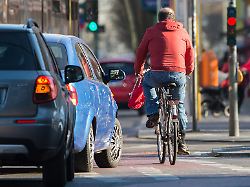Because of the increasing number of accidents
The federal government wants to allow indicators for bicycles
January 4, 2024, 4:48 p.m
The Ministry of Transport plans to allow turn signals on two-wheelers across the board in the future – regardless of whether they have a motor or without. However, critics are calling for other measures to improve road safety.
The federal government wants to allow indicators on bicycles in the future. “Optional direction indicators (turn signals) can replace the hand signal when indicating the turning process,” said the Federal Ministry of Transport and confirmed a report by the “Rheinische Post”. The reason is safety: The ministry is concerned about the increasing number of accidents involving Pedelecs, explained a spokeswoman.
Currently, indicators are only allowed on multi-track bicycles such as rickshaws. In order to indicate a turn, it is currently necessary to take your hand off the handlebars, explained the ministry spokeswoman. In difficult situations, this could lead to driving stability being impaired and braking behavior changed.
“The situation described here could be defused by optionally permitted direction indicators.” The General German Bicycle Club (ADFC) welcomed the project. Legal expert Roland Huhn told the “Rheinische Post” that direction indicators are easier to see than hand signals, especially in the dark. Particularly when turning left, serious collisions often occur because cyclists are overlooked.
The timing of the introduction of turn signal permits is still unclear
The transport policy spokesman for the Green parliamentary group, Stefan Gelbhaar, objected that normal road bikes were too narrow for indicators. The direction indicator can hardly be noticed. Instead, “good cycling infrastructure and appropriate speeds” make more sense for greater safety, emphasized Gelbhaar.
“Especially in urban areas, a speed limit of 30 helps to significantly reduce the risk of accidents and damage caused by accidents.” The Ministry of Transport stated that the requirements for optional indicators on bicycles should be introduced with the planned reorganization of the road traffic registration regulations.
The Ministry of Transport announced in mid-December that the draft of this StVZO should be sent to the Federal Ministry of Justice at the beginning of the year to “initiate the legal formality check”. “Due to the complexity of the extensive draft” it cannot yet be foreseen when the Federal Council will deal with the StVZO and when could come into force, explained the ministry spokeswoman.
Advocacy groups welcome change
The German Road Safety Council welcomed the plans. President Manfred Wirsch said that indicators could contribute to greater road safety and fewer injuries in road traffic. “Turning becomes safer because both hands remain on the handlebars, and the intention to turn is more visible to other road users, especially at night. Collisions with cyclists turning left often result in serious injuries and could be reduced in this way.”
A spokeswoman for the ADAC said that from the ADAC’s point of view the step was right and important for road safety. The current regulation is incomprehensible and no longer seems up-to-date. “Elderly people with physical limitations in particular find access to the bike easier with the electric assistance. They often find it difficult to give hand signals because one hand has to be taken off the handlebars.”
Siegfried Brockmann, head of accident research for the insurer, said that a turn signal obviously has advantages in the dark, especially if you want to turn and have to stop in the middle to wait for oncoming traffic. “On the other hand, there can also be additional dangers if I forget to turn off the indicator during the day. Overall, either way, this is definitely not a milestone in improving cycling safety.”
